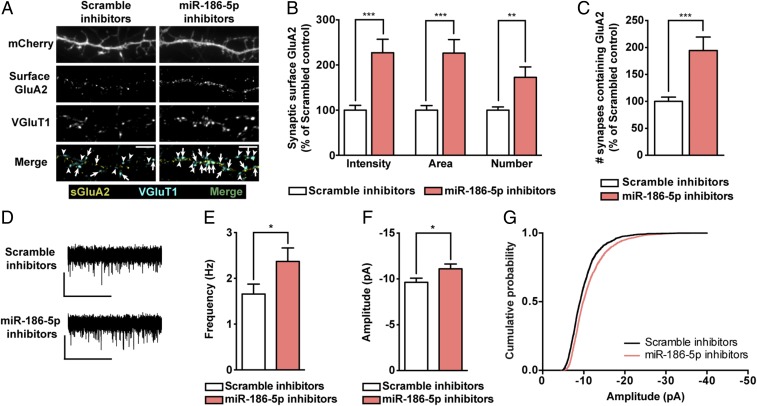Fig. 6.
Inhibition of miR-186-5p scales up excitatory synaptic strength. (A) Representative images of hippocampal neurons expressing miR-186-5p inhibitors or control scramble constructs and stained for surface GluA2, VGluT1, and MAP2. Transfected neurons were identified by expression of mCherry from the bicistronic miR-186-5p inhibitors expression plasmid. Arrows indicate colocalization of surface GluA2 (yellow) and VGluT1 puncta (cyan); arrowheads pinpoint GluA2-lacking VGluT1 puncta (cyan). (Scale bars, 5 μm.) (B) Intensity, area, and number of endogenous synaptic GluA2 clusters (colocalizing with VGluT1 clusters) normalized to synapse density (n = 49 cells from five independent experiments; Mann–Whitney test: **P ≤ 0.01, ***P ≤ 0.001). (C) Inhibition of miR-186-5p elevated the density of VGluT1+ synapses containing surface GluA2 (n = 49 cells from five independent experiments; Mann–Whitney test: ***P ≤ 0.001). (D) Representative whole-cell current traces of AMPAR-mediated mEPSCs from hippocampal neurons expressing a scramble sequence or miR-186–5p inhibitors. (Scale bars: vertical, 10 pA; horizontal, 5 s.) Expression of miR-186-5p inhibitors increased AMPAR-mediated mEPSC frequency (E) and amplitude (F) (n = 18 cells per condition, 10 independent experiments; Mann–Whitney test: *P ≤ 0.05). (G) Cumulative probability histograms of mEPSC amplitudes display the increase induced by miR-186-5p inhibition (n = 2,400 events recorded from 16 cells per condition, 10 independent experiments).

